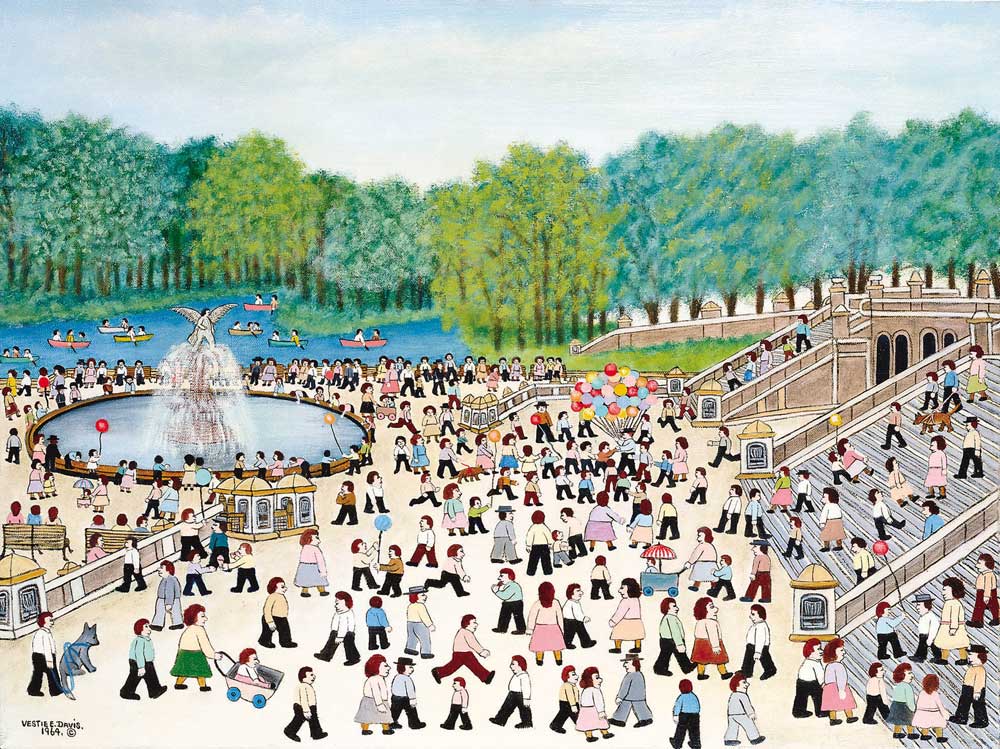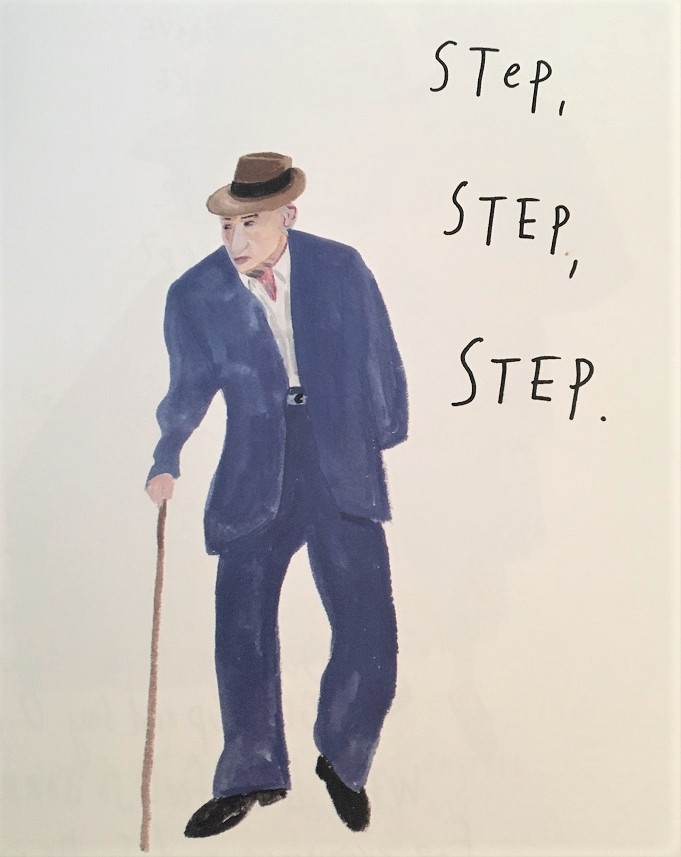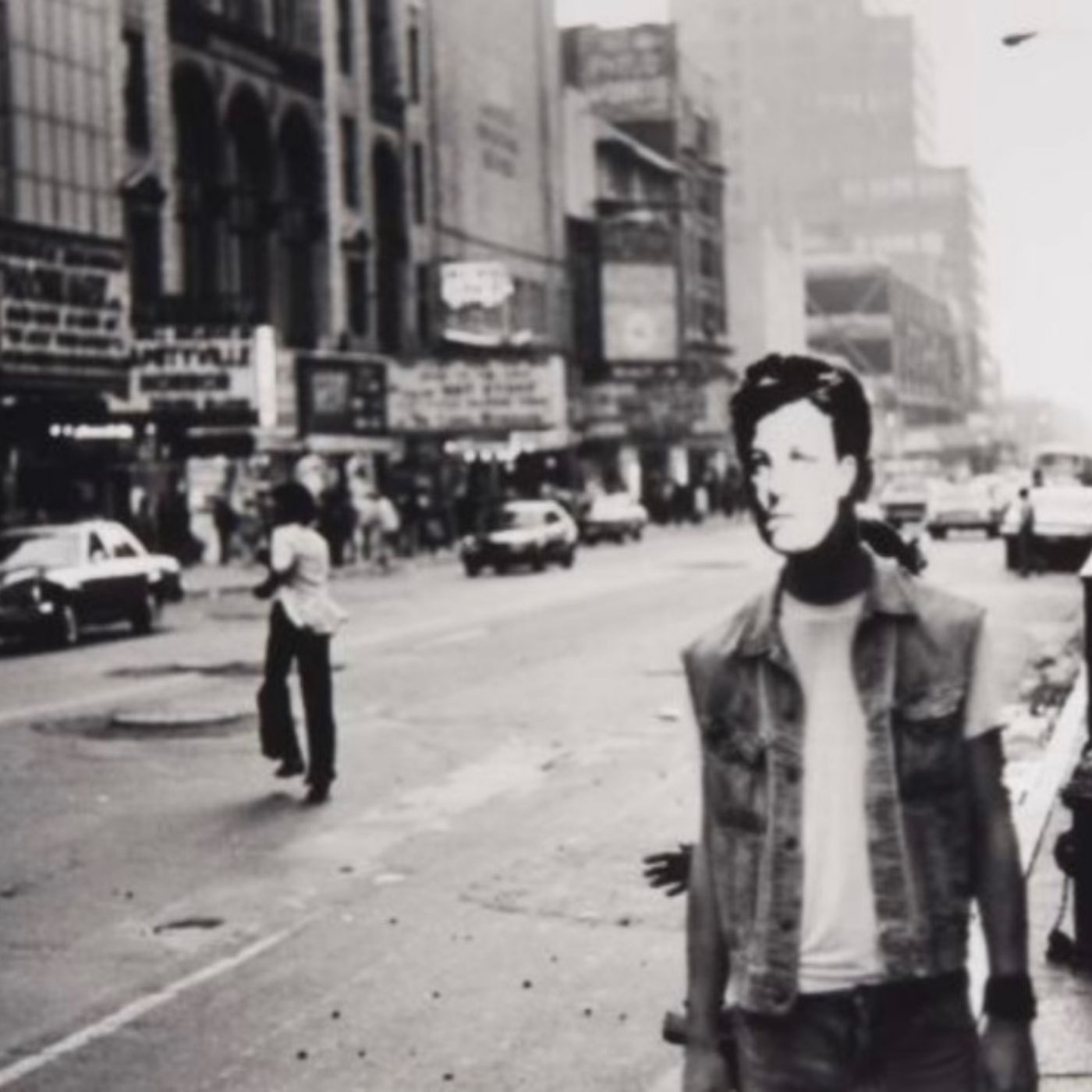"I am in a taxi stuck in traffic, I smile at the smiling man he nods his head courteously we know each other, our newyorkness."
Of his beloved city, children's author and essayist E. B. White wrote a lovely sentiment: "On any person who desires such queer prizes, New York will bestow the gift of loneliness and the gift of privacy." Such might be said of any large city, and indeed, there is an element of urban anonymity that we seek when traveling that draws us tourists to places like New York. What film critic Roger Ebert once called "Being By Myself in a City Where No One Knows Who I Am And No One Knows Where to Find Me."
 "Bethesda Fountain" by Vestie Davis (1964) courtesy of the American Folk Art Museum. Davis was an untrained artist whose New York venues were wildly popular in the 1960s and 70s. He painted New Yorkers coming and going.
"Bethesda Fountain" by Vestie Davis (1964) courtesy of the American Folk Art Museum. Davis was an untrained artist whose New York venues were wildly popular in the 1960s and 70s. He painted New Yorkers coming and going."Everyone is beautiful. Everyone makes you proud. Everyone Breaks your heart," New Yorker Maira Kalman once wrote of America, and I think that is a more accurate, if not more punchy, summation of this city. New York does seem to be all things at once, and those "things" begin and end with its people. The most observant among us, like Kalman and fellow New Yorker, Grace Paley, do more than sit and feast on the city's anonymity; they let it revolve around them until it breaks and things become known.
 Illustration by Maira Kalman in Principles of Uncertainty.
Illustration by Maira Kalman in Principles of Uncertainty.Poet Grace Paley (December 11, 1922 – August 22, 2007) spent her childhood and adult life in New York City but moved to Vermont in her later years. Places utterly different in character, Paley claimed both locales suited her persona. Her last collection of poems, Fidelity, resurfaces this need for human connection through place. Paley observes others with care and detail until they become real and known.
A New York city man is
standing on the street corner
he's smiling up at a fireman hanging
on to the ladder of his fire engine
the fire engine passes between us
slowly it turns the corner it is
going home to its firehouse
I am in a taxi stuck in traffic
I smile at the smiling man he
nods his head courteously we
know each other our newyorkness
Paley has long focused on place as a connective tissue of humanity and uses her Bronx-based background as the primary input. In her eighty-fourth year, she finished the poems in Fidelity. This last publication, redolent with the gifts and positivity of age, has a smattering of memory, insight, and moments of observation that seem to ask: are we so different?
Bravery on Tenth Street
This morning a man
his head hanging from~
the weak curved stem
of neck. feeble wife
beside him her hands
grip a walker a small
shopping bag knotted
to her wrist, she leans
slides toward him he
turns his head pain looks
up around alarmed steadies
her she is upright they
walk ten or twelve steps
are suddenly stalled
she begins to drift tremble
he stands a twisted bulwark
his eyes on the pavement how
to get home half a block
away was life this long?
There is something about watching other people walk - their step, where their eyes fall, how they shuffle around unrelenting aspects of the city. Do they respond to others? Do they seem lost in thought? Maira Kalman did this, as did sculptor Barbara Hepworth; watch people walk, give another person a few minutes of your attention as they pass in and out of view, nothing more than that.
And then, sometimes, as Paley discovers, they watch you back, and the heart opens up.
The Telling
I met a woman in the street she~
told me the whole story I said
yes yes then I told her the
whole story she said unbelievable
then I turned the corner there
was John he said but how did that
little family suddenly vanish
then walking walking we met
Elsa she said what's wrong with
you two you know the whole
story first the boy then him
then her then that was that but
they were just here John cried on
Seventh Avenue standing talking John
I said that was years ago no no
no said Elsa No said John. Oh
shut up both of you. I said
They’re gone
Zadie Smith made multiple observations of individuals in New York during the Covid crisis, giving them the same attention and space to be human. There is something vast, grand, and overwhelming about New York City; I know people who throw themselves into it and thrive and others who feel crushed quickly. I like to visit and certainly eat its food. And I really love reading about people who love New York, like Paley; there is little love like the love New Yorkers have for New York.
 "Village Art Show" by Vestie Davis, 1958. Although Davis' pictures depict famous New York locales, the city's citizens are highlighted subject matter. "The more people I put in, "Davis noted, "The faster they (i.e., the pictures) sold." Courtesy of The American Folk Art Museum.
"Village Art Show" by Vestie Davis, 1958. Although Davis' pictures depict famous New York locales, the city's citizens are highlighted subject matter. "The more people I put in, "Davis noted, "The faster they (i.e., the pictures) sold." Courtesy of The American Folk Art Museum.A small flip of the dice and the anonymity of a city turns into coldness, and abrasiveness. A space where those are excluded and pushed into furrows of loneliness.
the very little girl looked at her grandfather
the way he was sprawled across his big wheelchair
his leg was crooked it was bent the wrong way she
watched his leg for two or three minutes sometimes
it tried to move itself it was interesting she
gave him a Kleenex
British writer Olivia Liang explored the gifts of New York City's loneliness in her excellent The Lonely City and addressed how artists like Andy Warhol and David Wojnaorwics carved out their own space in a city that seemed to reject them. In doing so, Liang found, they defined themselves and their art within and against the city.
 "Arthur Rimbaud in New York," by David Wojnarowicz, 1978–79. Image courtesy the Estate of David Wojnarowicz.
"Arthur Rimbaud in New York," by David Wojnarowicz, 1978–79. Image courtesy the Estate of David Wojnarowicz.I sincerely believe that loneliness has a way of connecting us. In the commonality of physical space, we are able to cross that which divides us, even without contact. Many of us found this during Covid and Paley captures this beautifully in her poetry:
On the Park Bench
she is telling the story to another woman
the woman is listening she tells it again
the woman stops listening there is another
woman she tells her the story she tells it
again the woman walks away
do that? the story is interesting
must be heard three or four times What
will she do? she walks she thinks she'll go home
she walks she's tired she sits down
on a bench under the old elm
a woman is waiting
I have several motifs on The Examined Life, each representing things that matter to me as I write and curate this space. The bench represents a pause: an outward-turned pause, a pause with a view. We sit on a bench, and we watch. There is a moment of waiting and longing. Whether we sit or must from age or injury, a bench throws us together and re-positions our view. We become witnesses of small, simple acts of humanity. Paley's poetry is lovingly filled with this pause and observation.


